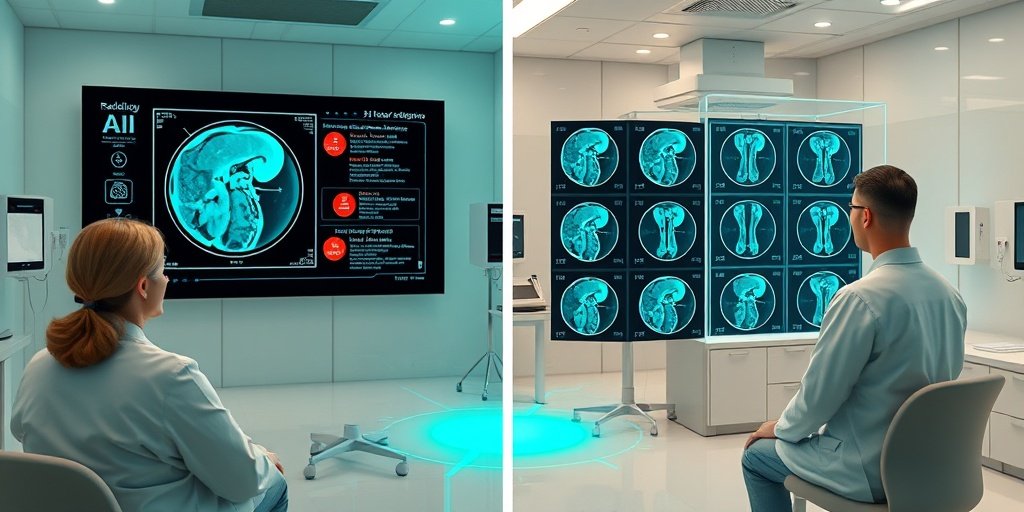⚡ Quick Summary
A recent study developed a deep-learning model for automated analysis of knee MRI studies, significantly enhancing the performance of resident radiologists. The model demonstrated an impressive AUC of at least 0.85 for multiple conditions, showcasing its potential in clinical practice. 🦵
🔍 Key Details
- 📊 Dataset: 3,121 MRI studies from 3,018 adults
- 🧩 Conditions analyzed: 23 conditions across cartilage, menisci, bone marrow, ligaments, and soft tissues
- ⚙️ Technology: 3D slice transformer network for binary classification
- 🏆 Performance: AUC ≥ 0.85 for 8 conditions, AUC ≥ 0.75 for 18 conditions
🔑 Key Takeaways
- 🤖 AI assistance improved accuracy and sensitivity for inexperienced radiologists.
- 📈 Inter-reader agreement increased for both inexperienced and experienced residents.
- ⏱️ Reading times were shortened by 10% for experienced residents (p = 0.045).
- 📉 Specificity slightly decreased when including conditions with low model performance (AUC < 0.75).
- 🌍 Clinical relevance lies in the model’s ability to help identify overlooked pathologies.
- 🔍 Future research should focus on fine-grained predictions for subtle or rare conditions.

📚 Background
The increasing utilization of MRI scans places significant pressure on radiologists, necessitating the development of comprehensive AI models for efficient image analysis. As the demand for accurate diagnostics grows, leveraging advanced technologies like deep learning becomes essential in enhancing radiological practices.
🗒️ Study
This retrospective dual-center study analyzed a substantial dataset of 3,121 knee MRI studies collected between 2012 and 2019. The researchers manually labeled 23 conditions affecting various knee tissues and trained a 3D slice transformer network for binary classification. The model’s performance was rigorously evaluated using a five-fold cross-validation approach and an external test set of 448 MRI studies from 2022-2023.
📈 Results
The deep-learning model achieved a remarkable AUC of at least 0.85 for eight conditions and maintained an AUC of at least 0.75 for 18 conditions. The model’s generalization on the external test set was robust, with a mean absolute AUC difference of only 0.05 ± 0.03 per condition. Notably, model assistance significantly improved diagnostic performance for inexperienced residents and enhanced reading efficiency for experienced residents.
🌍 Impact and Implications
The findings from this study highlight the transformative potential of AI in radiology. By improving the diagnostic performance and efficiency of resident radiologists, this deep-learning model not only aids in identifying pathologies that may be overlooked but also suggests a promising avenue for alleviating the increasing workload faced by radiologists. The integration of such technologies could lead to more accurate and timely diagnoses in clinical settings.
🔮 Conclusion
This study underscores the significant advancements that deep learning can bring to knee MRI analysis. The model’s ability to assist radiologists effectively paves the way for enhanced diagnostic accuracy and efficiency. As we look to the future, further research into fine-tuning these models for subtle conditions will be crucial in achieving comprehensive joint assessments in clinical practice. The journey of integrating AI into healthcare is just beginning, and the prospects are exciting! 🚀
💬 Your comments
What are your thoughts on the integration of AI in radiology? Do you believe it can significantly change the landscape of diagnostic imaging? Let’s discuss! 💬 Leave your thoughts in the comments below or connect with us on social media:
Comprehensive deep learning-assisted multi-condition analysis of knee MRI studies improves resident radiologist performance.
Abstract
OBJECTIVES: Developing a deep-learning model for automated multi-tissue, multi-condition knee MRI analysis and assessing its clinical potential.
MATERIAL AND METHODS: This retrospective dual-center study included 3121 MRI studies from 3018 adults, who underwent routine knee MRI examinations at a radiologic practice (2012-2019). Twenty-three conditions across cartilage, menisci, bone marrow, ligaments, and other soft tissues were manually labeled. A 3D slice transformer network was trained for binary classification and evaluated in terms of the area under the receiver operating characteristic curve (AUC), sensitivity, and specificity using a five-fold cross-validation and an external test set of 448 MRI studies (429 adults) from a university hospital (2022-2023). To assess differences in diagnostic performance, two inexperienced and two experienced radiology residents read 50 external test studies with and without model assistance. Paired t-tests were used for statistical analysis.
RESULTS: Averaged over cross-validation tests, the model’s AUC was at least 0.85 for 8 conditions and at least 0.75 for 18 conditions. Generalization on the external test set was robust, with a mean absolute AUC difference of 0.05 ± 0.03 per condition. Model assistance improved accuracy and sensitivity for inexperienced residents, increased inter-reader agreement for both groups, and increased sensitivity and shortened reading times by 10% (p = 0.045) for experienced residents. Specificity decreased slightly when conditions with low model performance (AUC < 0.75) were included.
CONCLUSION: Our deep-learning model performed well across diverse knee conditions and effectively assisted radiology residents. Future work should focus on more fine-grained predictions for subtle or rare conditions to enable comprehensive joint assessment in clinical practice.
KEY POINTS: Question Increasing MRI utilization adds pressure on radiologists, necessitating comprehensive AI models for image analysis to manage this growing demand efficiently. Findings Our AI model enhanced diagnostic performance and efficiency of resident radiologists when reading knee MRI studies, demonstrating robust results across diverse conditions and two datasets. Clinical relevance Model assistance increases the sensitivity of radiologists, helping to identify pathologies that were overlooked without AI assistance. Reduced reading times suggest potential alleviation of radiologists' workload.
Author: [‘Vuskov R’, ‘Hermans A’, ‘Pixberg M’, ‘Müller-Hübenthal J’, ‘Brauksiepe A’, ‘Corban E’, ‘Cubukcu M’, ‘Nowak J’, ‘Kargaliev A’, ‘von der Stück M’, ‘Siepmann R’, ‘Kuhl C’, ‘Truhn D’, ‘Nebelung S’]
Journal: Eur Radiol
Citation: Vuskov R, et al. Comprehensive deep learning-assisted multi-condition analysis of knee MRI studies improves resident radiologist performance. Comprehensive deep learning-assisted multi-condition analysis of knee MRI studies improves resident radiologist performance. 2025; (unknown volume):(unknown pages). doi: 10.1007/s00330-025-12052-8